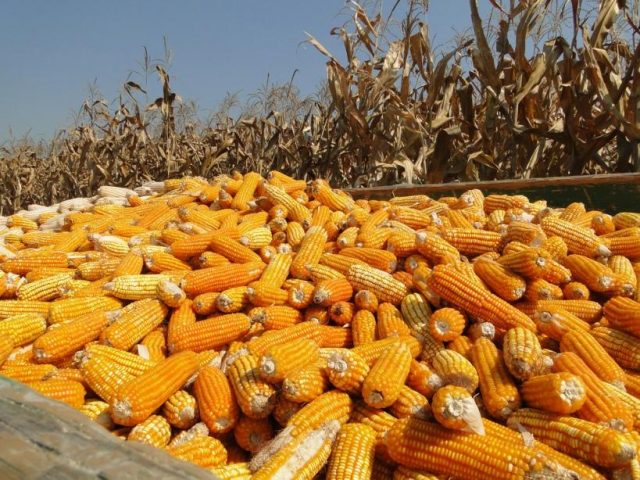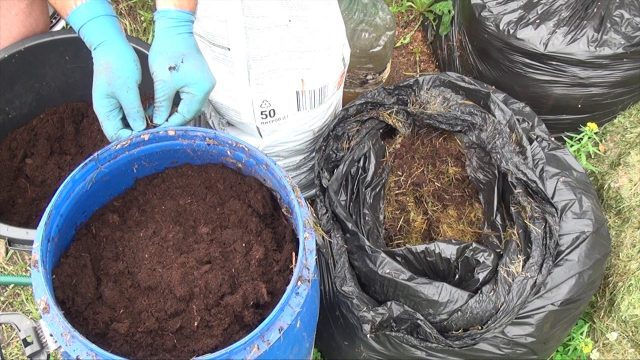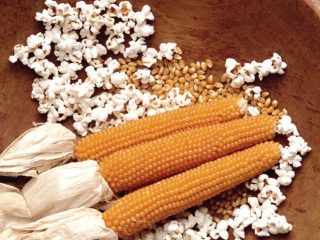Content
Corn is a traditionally southern crop, so it is grown on an industrial scale only in regions with a favorable climate. However, in the middle zone you can grow it in your summer cottage. Planting corn seeds in open ground is not difficult, but there are quite a few nuances in cultivating this crop.
How long does corn grow?
Corn is an annual herbaceous plant of the Poaceae family. Its growing season lasts from 3 to 5 months, depending on the variety. Powerful erect stems can reach 3 m or more. The grain seeds ripen at the end of the shoot.
They are quite large, round-cubic, tightly pressed to each other, collected at the end of the shoot into the so-called cob.The seeds grow in even rows; each cob can contain up to 1 thousand grains.
The best corn predecessors
The best precursors for corn are grains and legumes. On an industrial scale, these crops are often alternated with each other. Cereals and legumes (with the exception of peas, beans and beans) are grown quite rarely in the garden. Therefore, corn seeds are usually planted after potatoes or tomatoes, and in the south - after melons.
Timing for planting corn in open ground
Heat-loving corn is planted with seeds in open ground only after the soil temperature reaches + 10-14 °C. This time usually falls at the end of April or beginning of May. If by this time the soil does not have time to warm up to the required temperature, then you can try to grow corn in the country using seedlings. To do this, the seeds are germinated at home, and then, when the temperature reaches the required values, the seedlings are planted in open ground.
According to the lunar calendar 2019
Many gardeners are guided by the lunar calendar when planting seeds of various crops. Indeed, the phases of the moon have an impact on the growth and development of plants. The table below shows the recommended timing for planting corn seeds according to the lunar calendar.
Month | Favorable days | Unfavorable days |
March | 7-20 | 3,5,31 |
April | 6-18 | 5 |
May | 6-18 | 20,29,30 |
June | 4-16 | 3,11,25 |
Depending on the variety
There are quite a few varieties of corn. Like other garden crops, it is divided into several groups depending on the timing of ripening.
- Early. The growing season for such corn lasts 75-85 days.This includes varieties and hybrids such as Trophy F1, Jubilee F1, Landmark F1, Lakomka 121.
- Mid-season. Varieties of this group ripen in 90-100 days. This group includes Delicacy, Pearl, Mermaid.
- Late. Ripens in 100 days or more. These varieties include Bashkirovets, Polaris.
Depending on the purpose of cultivation
Depending on their purpose, all varieties of corn are divided into the following types:
- Sugar. Used for food and cooking.
- Dentoform. Characterized by high starch content. Used for technical purposes.
- Siliceous. Grown for livestock feed.
- Mealy. It is used for the production of starch, the production of molasses and bioethanol.
- Bursting. Due to its special structure, the grain bursts when heated, forming a soft white substance. The main purpose is the production of popcorn and other confectionery products.
- Membranous. Grown exclusively for feed purposes.
Corn is also divided according to sugar content, seed color and some other parameters.
How to plant corn in the garden with seeds
You can plant corn seeds either manually or using technical means. Before planting, you need to decide in advance on the growing location, since the site will require preliminary preparation. It is also worth assessing the weather conditions and the ability to care for the plantings. It is also necessary to take care in advance of purchasing seeds, which must be inspected before planting, and, if necessary, discarded.
Choosing a landing site
The best place for planting corn seeds will be a bright area well protected from the cold wind with loose, fertile soil. It is optimal if there are pumpkin or legume plantings nearby. Wide pumpkin leaves protect the soil well from overheating by the sun's rays, and legumes enrich the soil with nitrogen, which corn needs for normal growth.
Soil preparation
Corn prefers loose, fertile soil, so it is better to start preparing the area for planting in the fall. You need to dig it up, select the roots of the plants -weed, and also add fertilizer - rotted manure. In spring, the soil must be loosened again and cleared of weeds. When the required temperature is established outside, you can begin planting.
Soaking and germination of corn seeds
Before planting, corn seeds are kept in the sun for several days, first wrapped in a piece of cloth. After heating, they are disinfected. To do this, they are immersed for half an hour in a solution of potassium permanganate, diluted to a rich pink color. Then the seeds are washed with clean water and dried. After this, they are germinated. To do this, the grains are placed on a clean plate, alternating layers of seeds and gauze, which is moistened with water from a spray bottle.
Seeds placed for germination are placed in a warm, dark place. The plate can remain there for several days until sprouts appear. You just need to monitor the temperature and maintain the required humidity. Germinated seeds are planted in open ground.If for some reason it is not possible to germinate the seeds, they can be planted dry, after only being disinfected with a solution of potassium permanganate. In this case, the similarity will be worse, and the sprouts themselves will appear later.
Scheme for planting corn in open ground
Proper planting of corn seeds, depth and distance between rows depend on the chosen pattern. The most commonly used are single rad, double or lowercase.
Single Lane
With this method, the seeds are planted in 1 row, planting the seeds to a depth of 7-8 cm and placing adjacent holes at a distance of 30-40 cm from each other. This method does not create problems in care; it is quite easy to visually observe the plants.
Double row
A double row is the best way to plant corn from a pollination standpoint. With this method, two single rows are placed on the bed, the distance between them is 0.5 m.
Line row
Otherwise, this method is called square-nested, or chess. In this case, when planting in open ground, a gap of 0.3 m is left between neighboring plants in a row, and 0.6 m between rows. Seeds are planted to a depth of 10 cm. This method ensures ease of care and uniform illumination of plantings, but requires large sown areas.
Planting corn in the spring at the dacha - in a short video at the link:
Corn seeder
To grow corn in the country from seeds, it is not necessary to use a seeder; this only makes sense if there is a significant amount of sown area. It is unlikely that such a unit will be needed when planting seeds in a small area, if it is planned to occupy only 1-2 beds for this crop.If a large area is allocated for it, then in this case it is impossible to do without means of mechanization. Corn seeders come in manual, trailed and mounted varieties. The first ones are driven by muscular force and are intended for small areas. The latter are towed by self-propelled vehicles (tractor, walk-behind tractor) or hung on them. With the help of such devices, large areas can be sown with seeds in a short time.
The advantage of seeders is not only speed and productivity. The mechanized method allows for much more accurate compliance with the norms for sowing corn seeds in open ground, optimally placing them on the field and planting them exactly to the required depth. This significantly saves planting material and also increases productivity.
What can you plant next to corn?
The space between adjacent plants can be used to grow other plants, such as beans. Peas will do well in a corn field; the tall stems will serve as additional support for them. For the same reason, you can plant corn next to cucumbers. This method is a good alternative to growing cucumbers on trellises. Pumpkins and zucchini, as well as potatoes, grow well next to corn.
Tall plant stems provide quite a strong shadow, so light-loving crops next to them will systematically receive less solar energy. This will depress them. It is not recommended to plant the following plants next to corn:
- beets;
- celery;
- white and cauliflower;
- sweet and bitter peppers;
Tomatoes also do not tolerate proximity to corn. This culture is a pronounced egoist, therefore it is grown separately from all other plants.
Caring for corn crops in open ground
The technology and conditions for growing corn in open ground industrially do not require mandatory measures to care for crops after planting seeds in open ground. The only exception is the treatment of plantings against pests and diseases. However, when growing corn on a personal plot, especially in an unfavorable climate, some measures will be completely useful. These include:
- weeding;
- watering;
- loosening the soil;
- feeding
If all activities are carried out on time and in full, then it will not be difficult to grow a good crop of corn on the plot, even in a not very suitable climate.
How often to water corn
Watering corn in open ground is only necessary during dry periods. It should be rare but plentiful. Drip irrigation also gives good results, but its arrangement requires significant costs.
Top dressing
The need for fertilizing is determined by the color of the leaves. A pale green color indicates a lack of nitrogen, a purple tint indicates a deficiency of phosphorus. A lack of potassium leads to leaf deformation and leaf blades turning brown. To avoid such problems, fertilizing is applied in doses, observing certain time intervals.
The plants are fed for the first time 2 weeks after emergence with an infusion of mullein diluted with water in a ratio of 1:10. After the appearance of 5-6 full-fledged leaves, the procedure is repeated, using ammonium nitrate solution as a top dressing. The third feeding is carried out after another 15-20 days, using complex potassium-phosphorus fertilizers.
Loosening and removing weeds
Weeding of corn crops is usually done only at the initial stage of its growth. Tall plants with powerful stems and deep roots will do a good job of suppressing weeds. It is worth regularly loosening the soil, destroying the top crust for better air access to the roots. In adulthood, when the root system grows strongly, loosening is stopped so as not to damage the roots located close to the surface. Before this, the plants are earthed up to increase the number of adventitious roots and retain moisture.
Protection from diseases and pests
Despite the fact that many varieties have good resistance to diseases, plants can get sick in unfavorable climates. The danger for them is primarily fungal diseases. These include the following:
- dusty smut;
- blistering smut;
- fusarium;
- stem rot;
- southern helminthosporiosis.
As a preventive measure, seeds are treated with fungicides. Often, the disease develops on unharvested plant debris, so it is very important to put the beds in order after harvesting, removing all excess green mass from them. Affected plants must also be destroyed.
One of the causes of diseases is the appearance of insect pests on plantings, which can be carriers of fungal spores or pathogenic bacteria. The most common pests that appear on corn are:
- stem borer;
- root aphid;
- Swedish fly.
They fight insects by spraying plantings with fungicides, insecticides and biological agents.
When to Harvest Corn
There are two types of corn ripeness: milk and biological.When the corn grains reach milky ripeness, they become soft and their color turns light yellow. At the same time, it is still quite difficult to separate the leaves from the cob. Cobs with grains at the stage of milky ripeness are best suited for cooking and canning. If the grain is intended for technical purposes or for processing, then you should wait until it is completely ripe. A ripened ear of corn is easily peeled from its leaves, and the grains in it have a bright, rich yellow or orange color.
Conclusion
Planting corn seeds in open ground will not be difficult even for an inexperienced gardener. Further care of the plantings is also simple. If there is some free space on the plot, it is quite possible to take it up for growing this cereal. After all, boiled corn cobs are a favorite dish for many, especially children.














